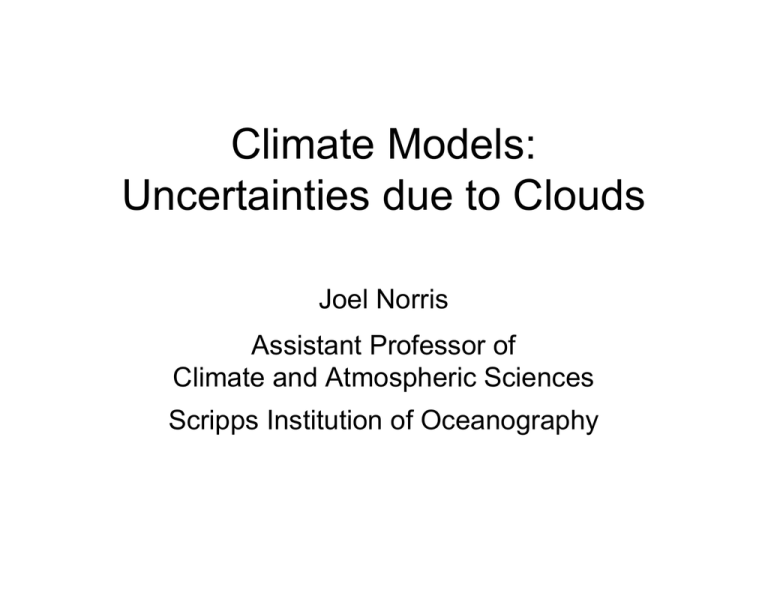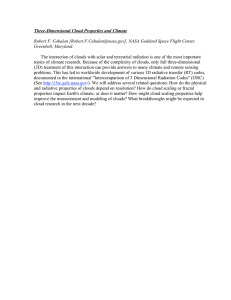Climate Models: Uncertainties due to Clouds Joel Norris Assistant Professor of
advertisement

Climate Models: Uncertainties due to Clouds Joel Norris Assistant Professor of Climate and Atmospheric Sciences Scripps Institution of Oceanography Global mean radiative forcing of the climate system for the year 2000 relative to 1750 Temperature response to anthropogenic radiative forcing ΔF = change in radiative forcing ΔT = change in surface temperature ΔT = ΔF × rate of change of T due to change in F climate λ = sensitivity The greater the climate sensitivity λ, the greater the warming. ΔT = ΔF × rate of change of T due to change in F + rate of change of T due to change in water vapor + rate of change of T due to change in ice + rate of change of T due to change in clouds + ... × λ0 for present-day water vapor, ice, clouds, etc. rate of change of water vapor due to change in F × rate of change of ice due to change in F × rate of change of clouds due to change in F feedbacks on climate λwv + λice + λcloud + … Role of feedbacks on the climate system ΔT = ΔF × λ λ = λ0 + λwv + λice + λcloud + … • positive feedbacks increase climate sensitivity (exacerbate global warming) • negative feedbacks reduce climate sensitivity (mitigate global warming) Cloud Radiative Forcing low-level clouds strongly reflect sunlight back to space (negative cloud radiative forcing) high-level clouds strongly restrict emission out to space (positive cloud radiative forcing) thick clouds strongly reflect and restrict emission (net zero cloud radiative forcing) Cloud Radiative Feedbacks Remember, forcing is not the same as feedback Positive cloud feedbacks if these occur with global warming: • decreased low-level cloud cover • decreased low-level cloud reflectivity • increased high-level cloud cover • increased height of highlevel cloud cover Negative cloud feedbacks if these occur with global warming: • increased low-level cloud cover • increased low-level cloud reflectivity • decreased high-level cloud cover • decreased height of high-level cloud cover Feedbacks in Global Climate Models Results of Cess et al. (1990) intercomparison of 19 atmosphere-only global climate models • climate sensitivity without clouds ranged from 0.4 to 0.57 (models agree) • climate sensitivity with clouds ranged from 0.4 to 1.22 (models disagree) • models did not even agree on whether the net cloud feedback was positive or negative Low-level cloud changes with temperature Observations r = –0.79 Climate System Model r = –0.21 Global climate models • the global atmosphere is divided into grid boxes • equations relating wind, radiation, temperature, moisture, etc. are solved to get new values for the next time step • adjacent grid boxes exchange radiation, mass, heat, moisture, etc. • coupled to models of ocean, ice, land surface, chemistry, ecosystem, … winds solar radiation infrared radiation temperature moisture T,q T,q Why do global climate models simulate clouds poorly? • grid boxes are typically 250 km wide and 1 km high • processes important for cloud formation happen at much smaller scales • it is very difficult to represent clouds and small scale processes from only grid box mean properties clouds small-scale circulations 1 km 250 km Parameterization Parameterization is representing the effects of unknown small scale properties from known grid box mean properties clear cloudy 105% 100% relative 95% humidity 90% 85% saturation distribution of relative humidity in grid box grid box grid box mean relative humidity Parameterization What if the grid box mean humidity is 90%? clear 100% saturation 95% relative 90% humidity 85% 80% distribution of relative humidity in grid box grid box grid box mean relative humidity Parameterization What if grid box mean humidity is 100%? clear cloudy 110% 105% relative 100% humidity 95% 90% saturation distribution of relative humidity in grid box grid box grid box mean relative humidity Parameterization Assuming the previous “triangular” distribution of relative humidity in the grid box, we now have a parameterization for percentage cloud cover C as a function of grid box mean relative humidity RH. C = 0% if RH < 90% C = 5 × (RH – 90%) if 90% > RH < 110% C = 100% if RH > 110% Note that the real world is much more complex than this simple example. Cloud–aerosol interactions • Aerosols are tiny particles in the atmosphere • Natural sources are dust, sea salt, and coagulation from gases of biological origin • Anthropogenic sources are fossil fuel and biomass combustion • Anthropogenic sources overwhelm natural sources over much of the globe • Aerosols can act as condensation nuclei for haze and cloud droplets to form on Anthropogenic aerosol radiative forcing “Direct Effect” • Sulfate aerosols reflect solar radiation back to space • Soot aerosols absorb solar radiation in the atmosphere instead of letting it reach the surface “Indirect effect” • More cloud condensation nuclei are available so more but smaller cloud droplets form • This can enhance cloud reflectivity by increasing scattering area (indirect effect 1) • This can enhance cloud lifetime by inhibiting coalescence of droplets and thus suppressing precipitation (indirect effect 2) Indirect Effect Natural State Effect Anthropogenic large number small number of of cloud cloud condensation nuclei large number small number of of large cloud small cloud droplets droplets low reflectivity high reflectivity Indirect Effect ship tracks Indian Ocean Cloud Experiment (INDOEX) • strong offshore flow during December-April brings polluted air over Northern Indian Ocean • Southern Indian Ocean provides “clean air” comparison • A very heavy and dark haze layer was observed over the Northern Indian Ocean • More and smaller cloud droplets were observed over the Northern Indian Ocean Conclusions • clouds have strong and varying radiative impacts on the climate system • clouds are the largest source of uncertainty in quantifying climate feedbacks and sensitivity • it is very difficult to simply and accurately parameterize the small scale processes affecting clouds in a global climate model • anthropogenic aerosol might have a large influence on cloudiness, but the overall impact is unknown • this is also difficult to parameterize in a global climate model




